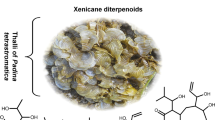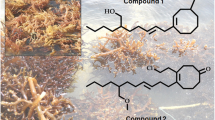Abstract
The marine ecosystem harbors unique and diverse bioactive compounds that can offer a vast repertoire of molecules with therapeutic properties. In the present study, four different species of red marine seaweeds were analyzed for its phytoconstituents and the potent antioxidant and anti-inflammatory activity of the methanolic extracts were screened and determined. The results revealed that, among the 4 samples, G. corticata, scored a good antioxidant potential by DPPH (67.61 ± 1.23%, IC50 = 577.7 µg) and metal chelation assay (29.40 ± 0.32%, IC50 = 1684 µg). The anti-inflammatory analysis has shown that, H. dialata was found to exhibit maximum inhibition against the albumin denaturation (83.50 ± 0.24%), whereas G. corticata was observed to measure a maximum inhibition in heat-induced hemolysis (60.40 ± 0.46%) and proteinase inhibition assay (83.30 ± 0.18%). An extensive literature survey was carried out for the bioactive compounds in G.corticata; it was examined for drug likeliness by ADME analysis and toxicological parameters. Further, the best selected bioactive compounds were subjected to in silico molecular docking with pro-inflammatory target, cyclooxygenase (COX-2). Hexadecanal and Neophytadiene were reported to obtain the highest binding affinity (−5.3) for COX-2 enzyme. Hence, in silico molecular docking studies had shown that G. corticata was found to possess potential anti-inflammatory activity that can prevent conversion of arachidonic acid to prostaglandins by inhibiting COX-2. In addition, molecular dynamic simulation studies have shown the stability of Hexadecanal-6 COX complex. To conclude, the outcomes of the present study may shed light on the understanding of the usage of bioactive compounds for therapeutic purpose.






Similar content being viewed by others
Data availability
Data will be made available on request.
References
Ağagündüz D, Kocaadam Bozkurt B, Bozkurt O, Sharma H, Esposito R, Özoğul F, Capasso R (2022) Micro biota alteration and modulation in Alzheimer’s disease by gerobiotics: the gut-health axis for a good mind. Biomed Pharmacother 153:113430
Ağagündüz D, Icer MA, Yesildemir O (2023) The roles of dietary lipids and lipidomics in gut-brain axis in type 2 diabetes mellitus. J Transl Med 21:240
Aparna V, Dileep KV, Mandal PK, Karthe P, Sadasivan C, Haridas M (2012) Anti-inflammatory property of n-hexadecanoic acid: structural evidence and kinetic assessment. Chem Biol Drug Des 80:434–439
Artis D, Spits H (2015) The biology of innate lymphoid cells. Nature.517:293–301
Batool R, Khan MR, Sajid M, Ali S, Zahra Z (2019) Estimation of phytochemical constituents and in vitro antioxidant potencies of Brachychiton populneus (Schott and Endl) R Br. BMC Chem 32:2–15
Bhardwaj M, Sali VK, Mani S, Vasanthi HR (2020) Neophytadiene from Turbinaria ornata suppresses LPS-induced inflammatory response in RAW 264.7 macrophages and sprague Dawley rats. Inflammation 43(3):937–950
Bittencourt JAHM, Neto MFA, Lacerda PS, Bittencourt RCVS, Silva RC, Lobato CC, Silva LB, Leite FHA, Zuliani JP, Rosa JMC, Borges RS, Santos CBR (2019) In silico evaluation of ibuprofen and two benzoylpropionic acid derivatives with potential anti-inflammatory activity. Molecules 24(8):1476
Brock TG, Peters-Golden M (2007) Activation and regulation of cellular eicosanoid biosynthesis. Sci World J 7:1273–1284
Chandra S, Chatterjee P, Dey P, Bhattacharya S (2012) Evaluation of in vitro anti-inflammatory activity of coffee against the denaturation of protein. Asian Pac J Trop Biomed 2(1):S178–S180
Chithra R, Chandra S (2013) Qualitative and quantitative analysis of phytochemical variation in G. corticata and K. alvarezii. Int J Sci Res Dev 1(10):2174–2176
Chou CT (1997) The anti-inflammatory effect of an extract of Tripterygium wilfordii hooks F on adjuvant-induced paw oedema in rats and inflammatory mediator’s release. Phytother Res 11:152–154
Ci KC, Indira G (2016) Quantitative estimation of total phenolic, flavonoids, tannin and chlorophyll content of leaves of Strobilanthes Kunthiana (Neelakurinji). J Med Plants 4:282–286
Das SN, Chatterjee S (1995) Long-term toxicity study of ART-400. Indian Indig Med 16:117–123
Das SK, Mahanta S, Tanti B, Tag H, Hui PK (2022) Identification of phytocompounds from Houttuynia cordata Thunb. as potential inhibitors for SARS-CoV-2 replication proteins through GC–MS/LC–MS characterization, molecular docking and molecular dynamics simulation. Mol Divers 26:365–388
Dastmalchi K, Dorman HD, Oinonen PP, Darwis Y, Laakso I, Hiltunen R (2008) Chemical composition and in vitro antioxidative activity of a lemon balm (Melissa officinalis L.) extract. Food Sci Technol 41:391–400
Goetzl EJ, Rosen H (2004) Regulation of immunity by lysosphingolipids and their G protein–coupled receptors. J Clin Invest 114(11):1531–1537
Artursson P, Avdeedf L, Ecker GF, Faller B, Fischer H, Houston JB, Kansy M, Kerns EH, Kramer SD, Lennernas H, Sugano K (2012) Drug Discov Today 17:905–912
Ferrali M, Signorini C, Ciccoli L, Comporti M (1992) Iron release and membrane damage in erythrocytes exposed to oxidizing agents, phenylhydrazine, divicine and isouramil. Biochem J 285(1):295–301
Ghosh N, Chakraborty T, Mallick S, Mana S, Singha D, Ghosh B, Roy S (2015) Synthesis, characterization and study of antioxidant activity of Quercetin-magnesium complex. Spectrochim Acta Part A Mol Biomol Spectrosc 151:807–813
Govindappaaga SS, Poojashri MN, Sadananda TS, Chandrappa CP (2011) Antimicrobial, antioxidant and in vitro anti-inflammatory activity of ethanol extract and active phytochemical screening of Wedelia trilobata (L) Hitchc. J Pharm Phytother 3:43–51
Gunathilake KDPP, Ranaweera KKDS, Rupasinghe HPV (2018) Influence of boiling, steaming and frying of selected leafy vegetables on the in vitro anti-inflammation associated biological activities. Plants 7:22
Harborne JB (1973) Phytochemical methods. Chapman and Hall, London, pp 49–188
Hiai S, Oura H, Nakajima T (1976) Color reaction of some sapogenins and saponins with vanillin and sulphuric acid. Planta Med 29:116–122
Hostettmann K, Marston A (1995) Chemistry and pharmacology of natural products. Cambridge University Press, Cambridge
Huang D, Ou B, Prior RI (2005) The chemistry behind antioxidant capacity assays. J Agric Food Chem 53:1841–1856
Islam ME, Islam KMD, Billah MM et al (2020) Antioxidant and anti-inflammatory activity of Heritiera fomes (Buch.-Ham), a mangrove plant of the Sundarbans. Adv Tradit Med (ADTM) 20:189–197
Jainab SIB, Azeez A, Fathima A, Kumar RR (2019) GC-MS analysis of the marine algae Halymenia dilatata Zanardini a potential source of fish feed in future. Indian Hydrobiol 18(1 & 2):164–169
Kalin P, Gulcin I, Goren AC (2015) Antioxidant activity and polyphenol content of cranberries (Vaccinium macrocarpon). Rec Nat Prod 9:496–502
Karamac M, Kosinska A, Amarowicz R (2006) Chelating of Fe (II), Zn (II) and Cu (II) by tannin fractions separated from hazelnuts, walnuts and almonds. Bromat Chem Toksykol 39:257–260
Kiefer JR, Pawlitz JL, Moreland KT, Stegeman RA, Hood WF, Gierse JK, Stevens AM, Goodwin DC, Rowlinson SW, Marnett LJ, Stallings WC, Kurumbail RG (2000) Structural insights into the stereochemistry of the cyclooxygenase reaction. Nature 405(6782):97–101
Landry J, Sutton A, Tafrov ST, Heller RC, Stebbins J, Pillus L, Sternglanz R (2000) The silencing protein SIR2 and its homologs are NAD-dependent protein deacetylases. Proc Natl Acad Sci 97:5807–5811
Leng J, Han C, Demetris AJ, Michalopoulos GK, Wu T (2003) Cyclooxygenase-2 promotes hepatocellular carcinoma cell growth through Akt activation: evidence for Akt inhibition in celecoxib-induced apoptosis. Hepatology 38:756–768
Meda A, Lamien CE, Romito M, Millogo J, Nacoulma OG (2005) Determination of the total phenolic, flavonoid and proline contents in Burkina Fasan honey, as well as their radical scavenging activity. Food Chem 91:571–577
Mitra S, Das R, Emran TB, Labib RK, Tabassum NE, Islam F, Sharma R, Ahmad I, Nainu F, Chidambaram K, Alhumaydhi FA, Chandran D, Capasso R, Wilairatana P (2022) Diallyl disulfide: a bioactive garlic compound with anticancer potential. Front Pharmacol 13:943967
Monir Uzzaman Md, Hasan K, Mahmud S, Fatema K, Matin MM (2021) Structure-based design of new diclofenac: physicochemical, spectral, molecular docking, dynamics simulation and ADMET studies. Inform Med Unlocked 25:100677
Moonmun D, Majumder R, Lopamudra A (2017) Quantitative phytochemical estimation and evaluation of antioxidant and antibacterial activity of methanol and ethanol extracts of Heliconia rostrata. Indian J Pharm Sci 79(1):79–90
Okoli CO, Akah PA, Onuoha NJ, Okoye TC, Nwoye AC, Nworu CS (2008) Acanthus montanus: an experimental evaluation of the antimicrobial, anti-inflammatory and immunological properties of a traditional remedy for furuncles. BMC Complement Altern Med 8:27
Oktay M, Gulcin I, Küfrevioglu OI (2003) Determination of in vitro antioxidant activity of fennel (Foeniculum vulgare) seed extracts. LWT-Food Sci Technol 36:263–271
Oso BJ, Adeoye AO, Olaoye IF (2022) (2020) Pharmacoinformatics and hypothetical studies on allicin, curcumin, and gingerol as potential candidates against COVID-19-associated proteases. J Biomol Struct Dyn 40(1):389–400
Pietta PG (2000) Flavonoids as antioxidants. J Nat Prod 63:1035–1042
Prieto P, Pineda M, Aguilar M (1999) Spectrophotometric quantitation of antioxidant capacity through the formation of a phosphomolybdenum complex: specific application to the determination of vitamin E. Anal Biochemm 269:337–341
Ragunathan V, Pandurangan J, Ramakrishnan T (2019) Gas chromatography-mass spectrometry analysis of methanol extracts from marine red seaweed gracilaria corticata. Pharmacog J.11(3):547–54
Rajkumar G, Bhavan PS, Srinivasan V, Udayasuriyan R (2017) Phytochemical screenings of the marine red alga, gracilaria corticata. Noble Int J Sci Res 90–97
Re R, Pellegrini N, Proteggente A (1999) Antioxidant activity applying an improved ABTS radical cation decolorization assay. Free Radic Biol Med 26:1231–1237
Rosales C (2018) Neutrophil: a cell with many roles in inflammation or several cell types? Front Physiol 9:113
Rowlinson SW, Kiefer JR, Prusakiewicz JJ, Pawlitz JL, Kozak KR, Kalgutkar AS, Stallings WC, Kurumbail RG, Marnett LJ (2003) A novel mechanism of cyclooxygenase-2 inhibition involving interactions with Ser-530 and Tyr-385. J Biol Chem 278(46):45763–45769
Sakat S, Juvekar AR, Gambhire MN (2010) In vitro antioxidant and anti-inflammatory activity of methanol extract of Oxalis corticata Linn. Int J Pharm Pharm Sci 2:146–155
Seibert K, Masferrer JL (1994) Role of inducible cyclooxygenase (COX-2) in inflammation. Receptor (4):17–23
Sharma V, Bhatia P, Alam O, Javed-Naim M, Nawaz F, Ahmad Sheikh A, Jha M (2019) Recent advancement in the discovery and development of COX-2 inhibitors: Insight into biological activities and SAR studies (2008–2019). Bioorg Chem 89:103007
Shinde UA, Phadke AS, Nari AM, Mungantiwar AA, Dikshit VJ, Saraf MN (1999) Membrane stabilization activity—A possible mechanism of action for the anti-inflammatory activity of Cedrusdeodora wood oil. Fitoterapia 70:251–257
Souza CRM, Bezerra WP, Souto JT (2020) Marine alkaloids with anti-inflammatory activity: current knowledge and future perspectives. Mar Drugs 18(3):147
Uma Maheswari M, Reena A (2017) Phytochemical profiling of the red seaweed, Halymenia dilatata by GC-MS Analysis. Int J Pharma Sci Res 167–172
Waisman A, Liblau RS, Becher B (2015) Innate and adaptive immune responses in the CNS. Lancet Neurol 14(9):945–955
Zelova H, Hosek J (2013) TNF‐alpha signaling and inflammation: interactions between old acquaintances. Inflamm Res 62:641–651
Zhang YJ, DeWitt DL, Murugesan L, Nair MG (2004) Novel lipid-peroxidation and cyclooxygenase inhibitory tannins from Picrorhiza kurrora seeds. Chem Biodiver 1:426–441
Acknowledgements
The authors are thankful to the management of Jain (Deemed-to-be University) for providing required facilities for carrying out the research work.
Funding
The authors declare that no funds, grants, or other support were received during the preparation of this manuscript.
Author information
Authors and Affiliations
Contributions
DES conceptualization, investigation, formal analysis. AM original draft writing—review and editing.
Corresponding author
Ethics declarations
Conflict of interest
The authors declare that they have no conflict of interest in the publication.
Ethical statement
Not applicable.
Rights and permissions
Springer Nature or its licensor (e.g. a society or other partner) holds exclusive rights to this article under a publishing agreement with the author(s) or other rightsholder(s); author self-archiving of the accepted manuscript version of this article is solely governed by the terms of such publishing agreement and applicable law.
About this article
Cite this article
Maheswari, A., Salamun, D.E. In silico molecular docking of cyclooxygenase (COX-2), ADME-toxicity and in vitro evaluation of antioxidant and anti-inflammatory activities of marine macro algae. 3 Biotech 13, 359 (2023). https://doi.org/10.1007/s13205-023-03770-1
Received:
Accepted:
Published:
DOI: https://doi.org/10.1007/s13205-023-03770-1




